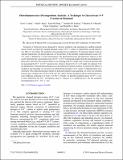| dc.contributor.author | Alsid, Scott T | |
| dc.contributor.author | Barry, John F. | |
| dc.contributor.author | Pham, Linh M | |
| dc.contributor.author | Schloss, Jennifer May | |
| dc.contributor.author | O'Keeffe, Michael F. | |
| dc.contributor.author | Cappellaro, Paola | |
| dc.contributor.author | Braje, Danielle A. | |
| dc.date.accessioned | 2020-03-24T21:18:17Z | |
| dc.date.available | 2020-03-24T21:18:17Z | |
| dc.date.issued | 2019-10-01 | |
| dc.identifier.issn | 2331-7019 | |
| dc.identifier.uri | https://hdl.handle.net/1721.1/124300 | |
| dc.description.abstract | Treatment of laboratory-grown diamond by electron irradiation and annealing has enabled quantum sensors based on negatively charged nitrogen-vacancy (N-V-) centers to demonstrate record sensitivities. Here we investigate the irradiation and annealing process applied to 28 diamond samples using an ambient-temperature, all-optical approach. As the presence of the neutrally charged nitrogen-vacancy (N-V0) center is deleterious to sensor performance, this photoluminescence decomposition analysis is first used to determine the concentration ratio of N-V- to N-V0 in diamond samples from the measured photoluminescence spectrum. The analysis hinges on (i) isolating each N-V charge state's emission spectrum and (ii) measuring the N-V- to N-V0 emission ratio, which is found to be 2.5±0.5 under low-intensity 532-nm illumination. Using the photoluminescence-decomposition-analysis method, we measure the effects of irradiation and annealing on conversion of substitutional nitrogen to N-V centers. Combining these measurements with a phenomenological model for diamond irradiation and annealing, we extract an estimated monovacancy creation rate of 0.52±0.26cm-1 for 1-MeV electron irradiation and an estimated monovacancy diffusion coefficient of 1.8 nm2/s at 850 C. Finally, we find that irradiation doses of 1018e-/cm2 or more deteriorate the N-V- decoherence time T2, whereas T1 is unaffected up to the the maximum investigated dose of 5×1018e-/cm2. | en_US |
| dc.language.iso | en | |
| dc.publisher | American Physical Society (APS) | en_US |
| dc.relation.isversionof | 10.1103/physrevapplied.12.044003 | en_US |
| dc.rights | Article is made available in accordance with the publisher's policy and may be subject to US copyright law. Please refer to the publisher's site for terms of use. | en_US |
| dc.source | APS | en_US |
| dc.title | Photoluminescence Decomposition Analysis: A Technique to Characterize N-V Creation in Diamond | en_US |
| dc.type | Article | en_US |
| dc.identifier.citation | Alsid, Scott T. et al. "Photoluminescence Decomposition Analysis: A Technique to Characterize N-V Creation in Diamond.' Physical review applied 12 (2019): 044033-1 to 044033-20 © 2019 The Author(s) | en_US |
| dc.contributor.department | Massachusetts Institute of Technology. Department of Nuclear Science and Engineering | en_US |
| dc.contributor.department | Massachusetts Institute of Technology. Department of Physics | en_US |
| dc.relation.journal | Physical review applied | en_US |
| dc.eprint.version | Final published version | en_US |
| dc.type.uri | http://purl.org/eprint/type/JournalArticle | en_US |
| eprint.status | http://purl.org/eprint/status/PeerReviewed | en_US |
| dc.date.updated | 2020-02-20T18:25:56Z | |
| dspace.date.submission | 2020-02-20T18:25:58Z | |
| mit.journal.volume | 12 | en_US |
| mit.journal.issue | 4 | en_US |
| mit.license | PUBLISHER_POLICY | |
| mit.metadata.status | Complete | |
